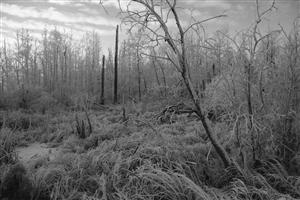Factors Affecting Water and Sediment Quality: Climate and River Flow
Rainfall and temperature are the most important aspects of climate, and both influence the aquatic environment. The amount and timing of rainfall are strongly linked to hydrological patterns within drainage basins, so seasonally varying precipitation produces seasonal differences in river discharge and patterns of flooding—and thus seasonal differences in the physical and chemical characteristics of the river. In the Athabasca River, high flows during the spring melt result in elevated concentrations of suspended sediments and chemical species associated with sediments (e.g., total aluminum) (RAMP 2007, RAMP 2005).
River discharge has important effects on water quality, including the dilution of dissolved substances at high flows and the suspension of sediment particles eroded from the river banks or substrate by high flows. Rainfall can also cause erosion within the drainage basin, and elevated surface flows can carry eroded sediment to the river. Flooding can result in the exchange of nutrients between flooded river banks and the river itself. Temperature influences the rate of chemical reactions as well as physical processes such as evaporation and the melting of ice and snow.
Rain and snow contain a wide variety of chemical substances that can affect the quality of the aquatic environment they eventually reach. Some substances, such as the sulphuric and nitric acids found in acid rain, can lower the pH of aquatic environments. Atmospheric deposition of persistent organic pollutants, mercury, and acidifying compounds are a potential concern in the Athabasca region for health and ecological reasons.









